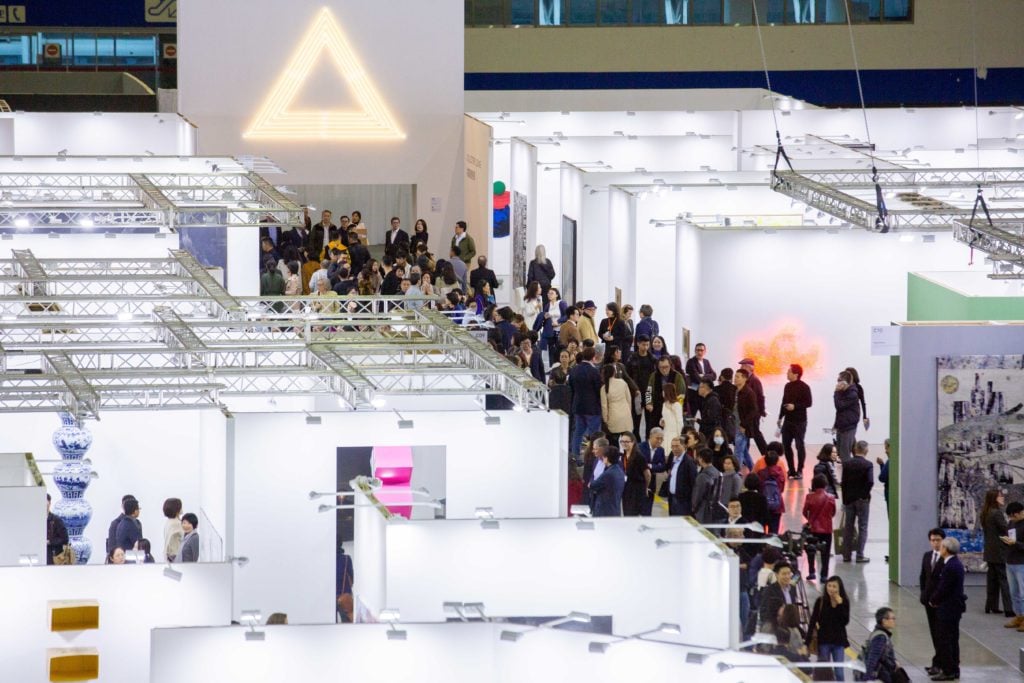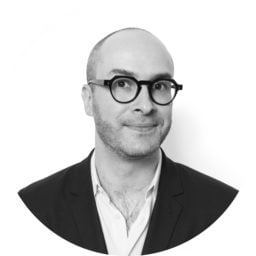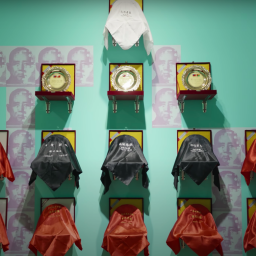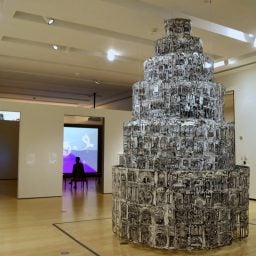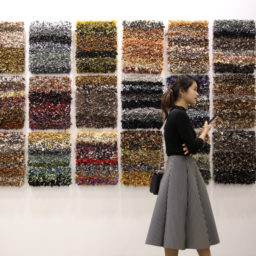On a recent Saturday evening, as peppy soft rock boomed from arena-worthy speakers and searchlights spun through the night sky, thousands of Taiwanese hipsters streamed through the vast square outside Taipei’s national Chiang Kai-shek memorial to take in a marvelously strange apparition: an 11-story-tall death’s-head cartoon figure idly lounging on the paving stones and seeming to appreciate the city skyline.
The signature character of the Brooklyn graffiti artist-turned-commercial sensation KAWS, this mellow inflatable titan was brought to Taiwan’s capital by the pop star JJ Lin, whose production company turned the occasion into a merchandizing bonanza, with vendors selling $50 t-shirts and $199 figurines to snaking lines of fans.
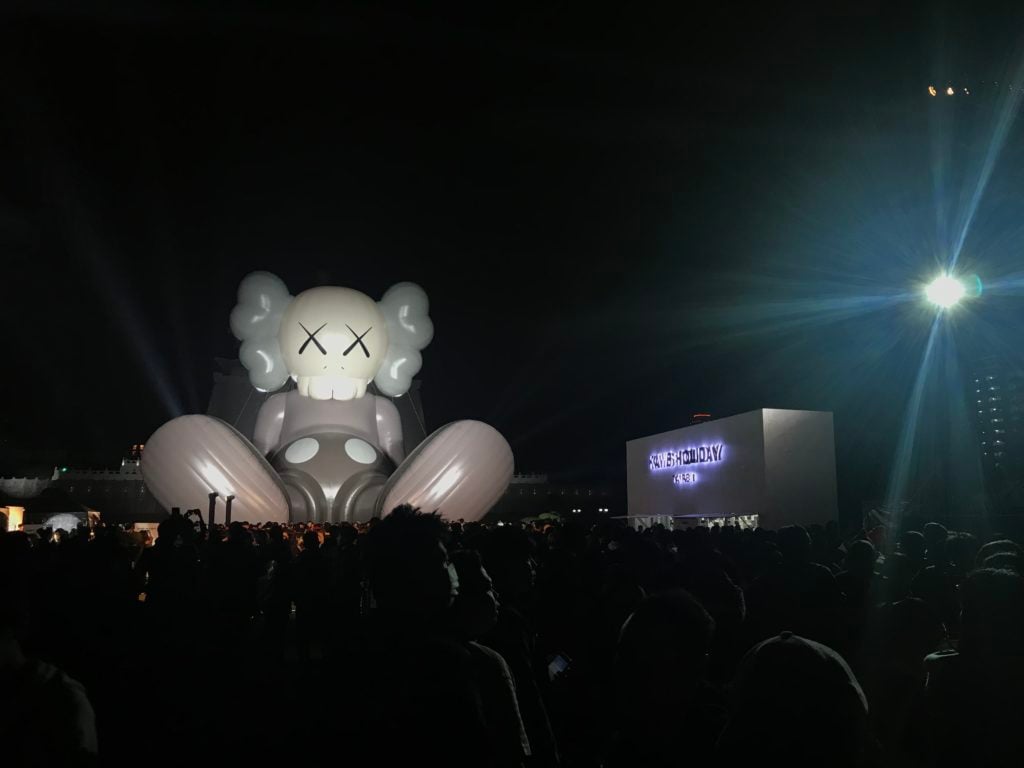
The “KAWS: HOLIDAY” installation outside the National Chiang Kai-shek Memorial Hall. Photo by Andrew Goldstein.
Timed to coincide with the opening of the city’s inaugural Taipei Dangdai art fair, the giant balloon is an apt metaphor for the swelling ambitions of Taiwan’s cultural scene, which is angling to establish itself as a new hub for the booming Asian art world. Viewed from another angle, it also represents the enormous opportunity the Western art industry sees to expand its Asian business beyond China’s jaw-dropping but ferociously complex economy as a taste for American and European contemporary art spreads through the region.
After a week spent in Taipei for the art fair and its orbiting constellation of events, one thing is clear: how these two forces—the dynamism of the regional scene and the growing number of Western galleries prospecting for business—intersect over the coming years will do much to shape the future of art in this century.
Why Taiwan?
For dealers from Europe and America, Taiwan’s appeal basically comes down to the fact that it’s not China. While the past few years have seen an explosion in investment by Western galleries in Hong Kong—and, to a lesser extent, in Shanghai and Beijing—headway there has been hard-fought, halting, and extremely expensive.
Taiwan, on the other hand, is a largely untapped market with far fewer barriers to entry. Having separated from China in 1949 during the civil war, Taiwan experienced economic growth more rapidly than the mainland, with its world-class technology sector fueling prosperity during the 1980s and ‘90s and enriching a pool of highly sophisticated art collectors that Western dealers initially catered to—but then stopped when the art market revved up in Hong Kong.
Now, with initiatives like Taipei Dangdai, Taiwan “is an old frontier that is made new again,” according to the New York art dealer Sean Kelly, who unveiled a new permanent project space in Taipei during the fair.
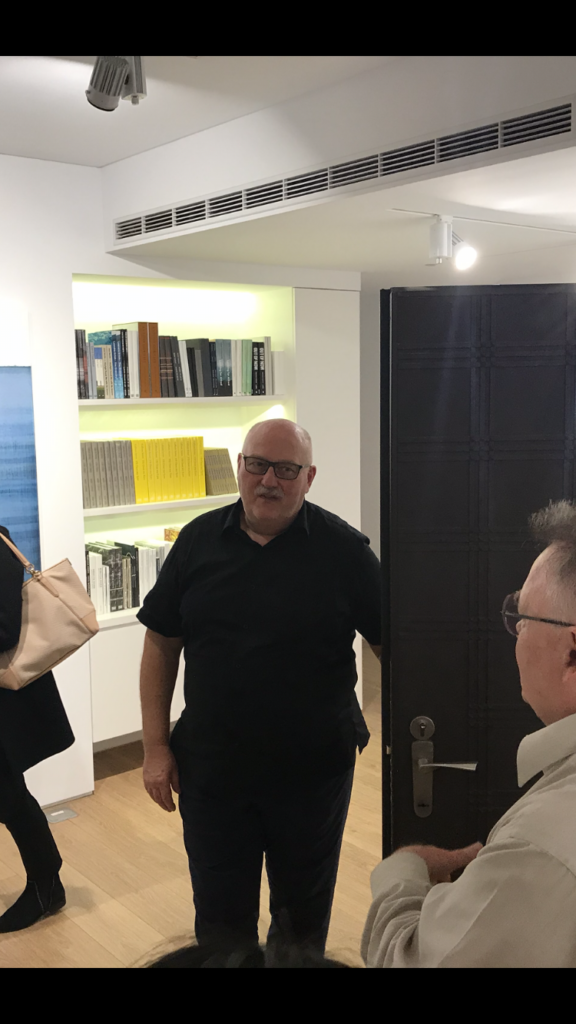
Sean Kelly receiving guests at his new Sean Kelly Asia outpost in Taipei. Photo by Andrew Goldstein.
“There are challenges with China at the moment—political, financial, and having to do with the American trade war—and Taiwan isn’t confronted by those same considerations,” Kelly said on a walk through his modest space, which debuted with a show of gridded abstractions by Callum Innes. “Taxes are low, it’s a very stable economy, it’s got many generations of collectors, and it’s a free country, effectively, which China is not, and Hong Kong is not either. Some people might not feel the same way, but it’s being ingested too. If Taiwan gets ingested, we won’t be worrying about the art market—we’ll be worrying about World War III.”
Until that time, there is another practical consideration that makes Taipei attractive: with rents at least 25 percent cheaper than Hong Kong—which was recently ranked the world’s least affordable city for the ninth year in a row—it’s also useful as an “independent jumping-off spot” where you can get to Singapore, Korea, Japan, and Indonesia quickly.
“It’s an opportunity for us to look at other artists from the region and renew our New York program at the same time,” Kelly said. For that reason, the new outpost is called Sean Kelly Asia, not Sean Kelly Taipei.
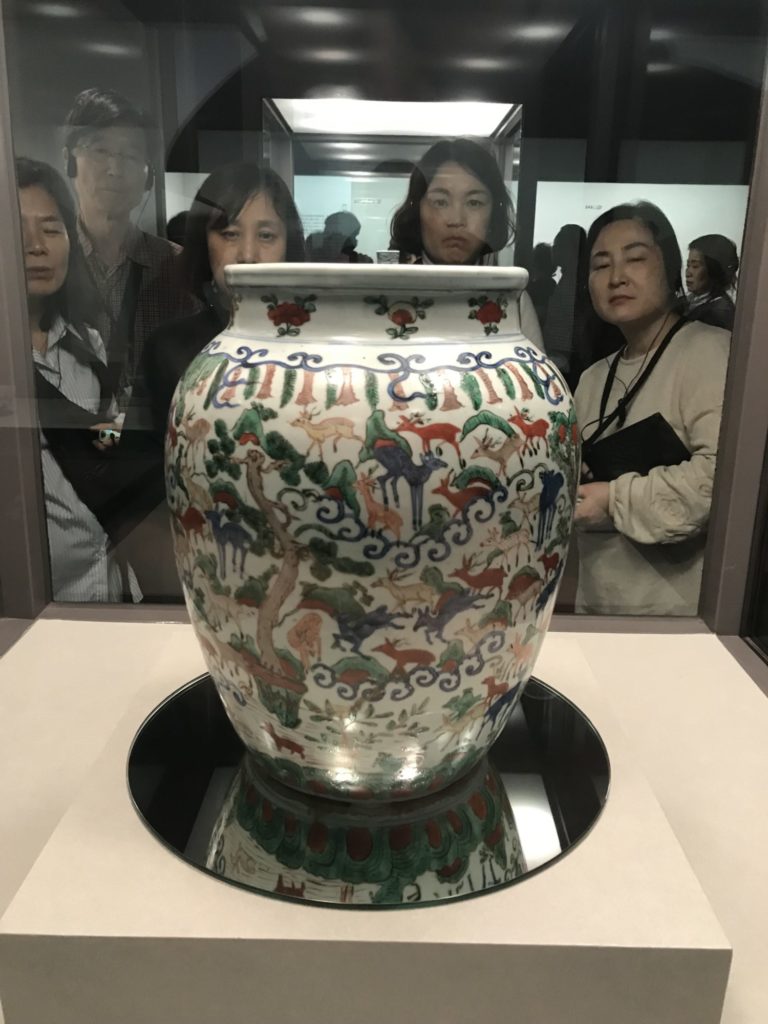
Visitors at Taipei’s National Palace Museum. Photo by Andrew Goldstein.
The collectors in Taipei, meanwhile, represent significant potential buying power. Auction houses have long had success in the country due to its multigenerational collecting families. Between 2008 and 2017, the value of art that Sotheby’s sold to Taiwanese collectors worldwide tripled. (Auction houses also have a habit of recruiting specialists from Taiwan due to the familiarity its elite families have with art and its unusually high percentage of fluent English speakers.)
However, Sean Kelly Asia director Gladys Lin noted, these upsides come with challenges. Families collecting together need to build consensus—and the Taiwanese already tend to be more deliberate than other collectors, having inherited reticence from their longtime Japanese colonizers, she said. The result is that sales tend to happen slowly, particularly for contemporary art, which remains a novelty.
This attitude is epitomized by the city’s 26-year-old Ching Wan Society, an elite group of art-collecting industrialists devoted to the acquisition and appreciation of Chinese ceramics, ink paintings, and other art from the classical period up to 1950s. (The local hardware magnate Leo Shih, a member of Taipei Dangdai’s advisory committee, acknowledged, “we’re a bit slower to buy—it’s like sous vide.”)
Kelly plans to mirror this pace with his outpost. “I feel a lot of my colleagues have landed here, godlike, and emerged from their spacecrafts to tell the local population about contemporary art,” he said. “I don’t think that’s a very sensitive approach. We want to land here in a quiet way to learn the landscape and then build out from there.”
Taipei Dangdai
Located on the fourth floor of the Taipei Nangang Exhibition Center, in a cavernous exhibition hall distinguished by its 81-foot-high vaulted ceilings, Taipei Dangdai is an optimal landing pad for Western dealers to dock their spacecrafts—or whatever mode of entry they prefer.
Twenty premier international galleries, including Pace and Gagosian, made the journey from faraway art capitals largely because of their faith in the event’s founder, Magnus Renfrew, who is widely regarded as a visionary for bringing Art Basel Hong Kong into being, supercharging the mercantile island as Asia’s international contemporary art hub.
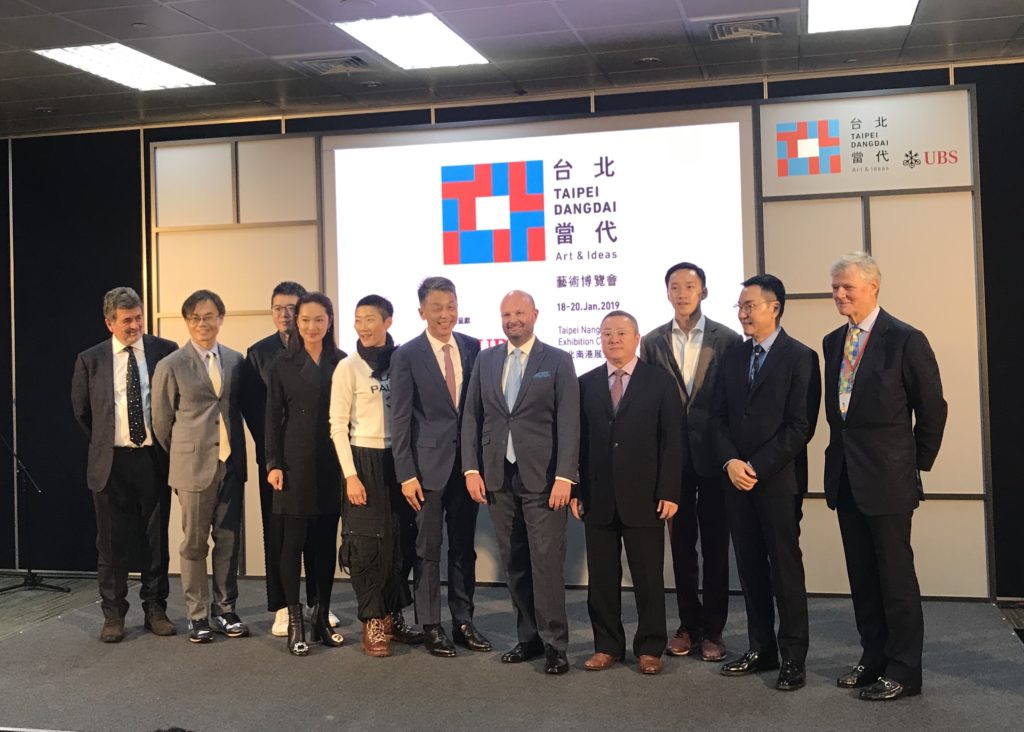
Magnus Renfrew (center, blue tie) posing with Taipei Dangdai’s advisory board on opening day. Photo by Andrew Goldstein.
This time, Renfrew explained that his vision is to turn the focus away from Western all-stars and toward the region’s own galleries “to demonstrate that Taipei is a viable art market” year-round. But even though Western galleries account for little more than a fifth of the fair’s exhibitors, Renfrew acknowledged that their presence remains dominant due to the sheer size of their booths: “The experience is more like 50 percent.”
On the VIP opening day, when luminaries as diverse as Taiwanese movie star Alyssa Chia, Tate’s Gregor Muir, and the powerful collectors Uli Sigg and Budi Tek dotted the crowds, the foreign dealers on hand had tamped-down expectations. At White Cube’s booth, where a painting of two upside-down figures by Georg Baselitz—by far the most visible Western artist at the fair—hung next to spectral table and chairs by Mona Hatoum, dealer Daniela Gareh said the gallery hoped to expand its network of “several” collectors in Taiwan.
“If we can place four or five of the key works we would be very happy, but we’re not expecting much from this first fair,” she said. “It’s about consolidating and strengthening our relationships in the region.” By the end of the weekend, the Baselitz had sold (asking price: €650,000), along with pieces by Antony Gormley, Anselm Kiefer, and Darren Almond.
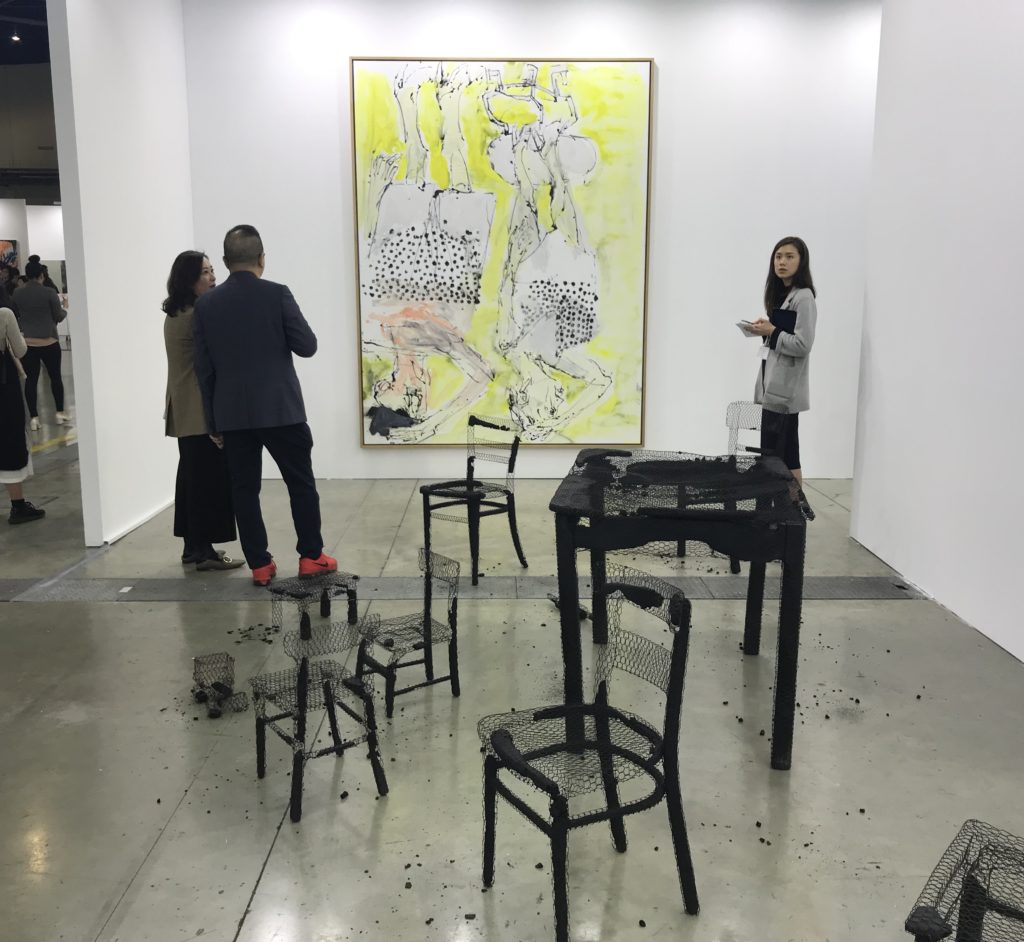
Work by Georg Baselitz and Mona Hatoum at the White Cube booth. Photo by Andrew Goldstein.
Paris dealer Thaddaeus Ropac, who also anchored his booth with a €1 million Baselitz (the artist “has a really strong market in Asia,” he said), had a similar approach.
“China is the biggest market and will be for a long, long time—you just cannot compare the volume and the speed they move along,” said Ropac. “At the same time, you have these other powerhouses around Asia. Now, in Taiwan too, they’re getting faster at decision-making. In the beginning it took a really long time and they missed things. Now they know that if you really want something, you have to move.” His strategy for encouraging new clients, he said, is to bring an artist repeatedly to the region across multiple fairs to build up a drumbeat of familiarity.
Along with Ropac, other Western dealers who made the trip included Pace’s Marc Glimcher, David Zwirner, and Sadie Coles, each of whom could be found at their booths on opening day. Zwirner reported “strong sales” at his galleries—including a Yayoi Kusama “Infinity Net” painting for around $1 million, a Wolfgang Tillmans photo for $350,000, and two Neo Rauch paintings for $650,000 and $325,000—noting he was “particularly glad that most of the works we sold went to local collections.” Pace, meanwhile, sold a Yoshitomo Nara bronze, a Nigel Cooke, a Kiki Smith tapestry, and several pieces by Kohei Nawa.
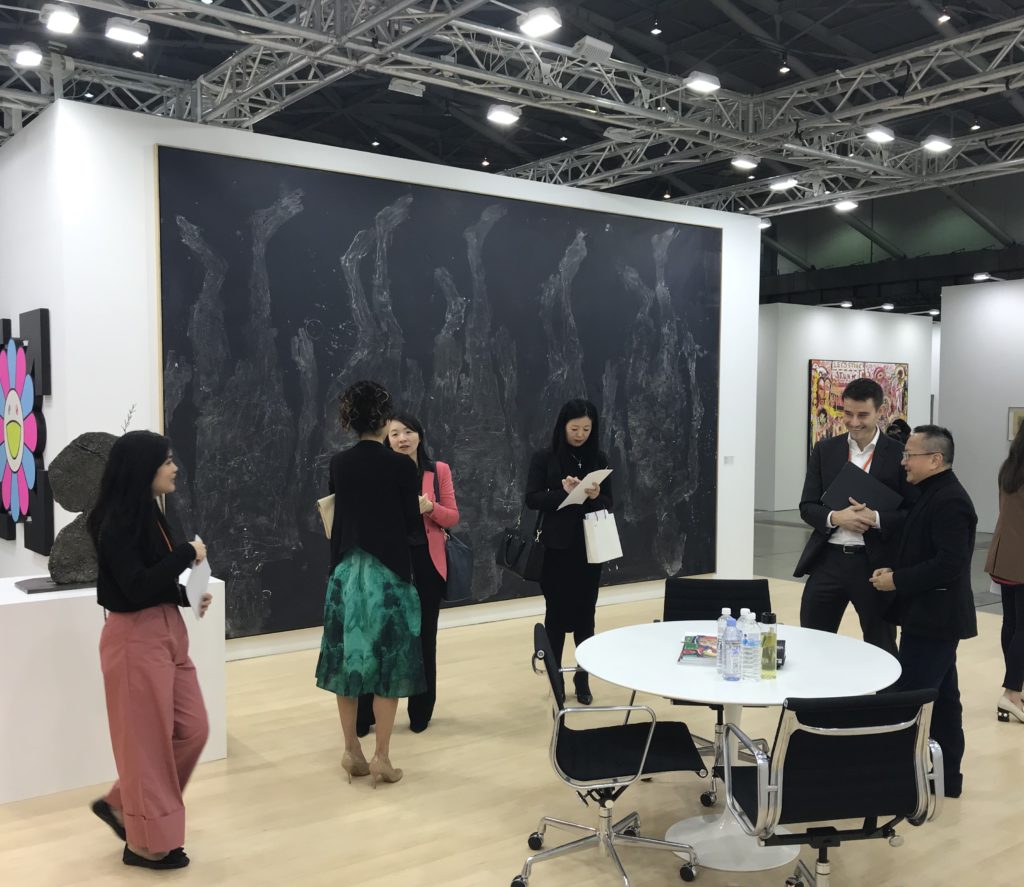
Another giant Baselitz anchored Gagosian’s booth. Photo by Andrew Goldstein.
Other notable sales by Western galleries at the fair included a £750,000 mirrored Anish Kapoor and two £35,000 works by Julian Opie—whose massive popularity in Asia earned him a takeover of Seoul’s equivalent of Times Square—at Lisson Gallery; four George Condo works at Sprüth Magers, including a $350,000 painting; an eight-foot Do Ho Suh vitrine for around $200,000 at Lehmann Maupin; and five Günther Förg paintings from Hauser & Wirth’s booth devoted to the artist, with two selling for roughly half a million dollars each.
Still, dealers in general reported that there was a lot of work to be done to cultivate a meaningful population of contemporary-art buyers in Taiwan. Renfrew, for his part, acknowledged as much—that’s why he created a special section devoted to local galleries selling recent artworks priced at $8,000 and under “to reduce the intimidation factor.” Collectors remain primarily interested in traditional fare, he said, but “once you start collecting contemporary art from your own culture it’s not a big leap to begin collecting from other areas too.” Still, he noted, it may take another generation to truly tip the scales in favor of contemporary.
The Younger Generation
Anyone pinning their hopes on the rising generation of Taiwanese collectors would have been heartened to attend the the “Urban Jungle” party celebrating the opening of Taipei Dangdai. Hosted by Leslie Sun, an influential local collector and lifestyle guru with a taste for German art and a seat on the fair’s advisory committee, the thumping party marked the launch of the Young Collectors Club of Taiwan, which Sun co-founded to unite her friends around their shared passion for contemporary art.
Guests at the party, some dressed in sharp suits and others in edgy athleisure (the party was sponsored by GQ and Vogue, as well as Mercedes Benz), sipped 12-year-old whiskey while listening to DJ sets at the foot of the future $1 billion skyscraper Taipei Sky Tower. An illuminated sign asked visitors to help “curate a showcase art piece” for the project to become “the future iconic artwork in Taiwan,” showing Anish Kapoor’s Cloud Gate, a Louise Bourgeois spider, and Charging Bull on Wall Street as examples. The air crackled with ambition.
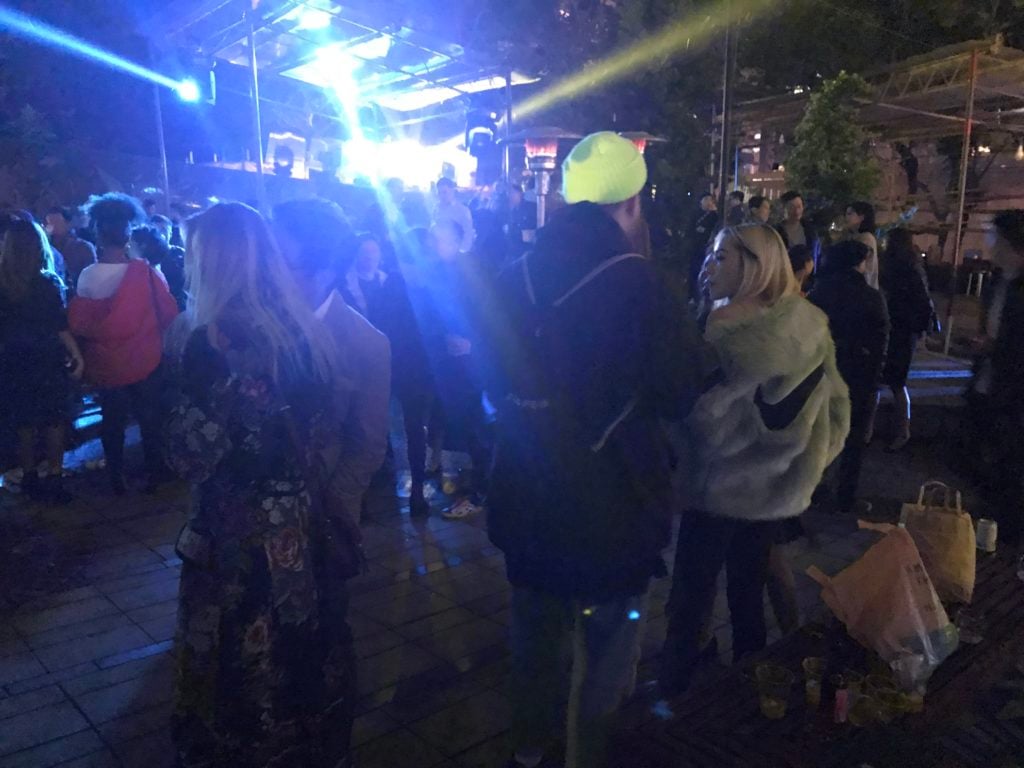
The Urban Jungle party in Songzhou Square Park. Photo by Andrew Goldstein.
A mediagenic—and media-savvy—entrepreneur with close-cropped hair and killer style, Sun is a passionate booster for Taipei’s contemporary art scene. “As a young collector, I’m very excited about Taipei Dangdai,” she said. “I feel my generation of collectors is really open-minded, but many of my friends are not able to travel abroad to see art as much as they would like, either because of their work or their families.”
But while Sun, a staple at fairs like Art Basel Miami Beach and Frieze London, is happy to see those galleries visit her hometown, she said she was most excited about the fair’s profusion of regional galleries. “It’s rare to see such a wide spectrum in one place,” she said. “You can really see their local character. You can really tell when something is Japanese, when something is Korean.”
Sun added that, while Taiwanese galleries originally saw “all these Western galleries coming in as huge competition,” local purveyors might actually be the biggest beneficiaries of their presence—because while their buzz may bring in collectors, those collectors are still only beginning to dip their toes into Western art.
This sense of an insurgent marketplace for Asian art is shared by the dealer Shelly Wu, the daughter of preeminent Taipei gallerist Tina Keng and the proprietor of the contemporary-oriented TKG+ gallery. Having studied design at FIT in New York a decade ago, Wu returned to her hometown with a plan to nurture artists from the region beyond China, whose contemporary-art boom she saw as being caught up in a market-driven fever. “From the beginning, I wanted to work with artists from Hong Kong, Thailand, Singapore, Cambodia,” she said. I just felt there was space.”
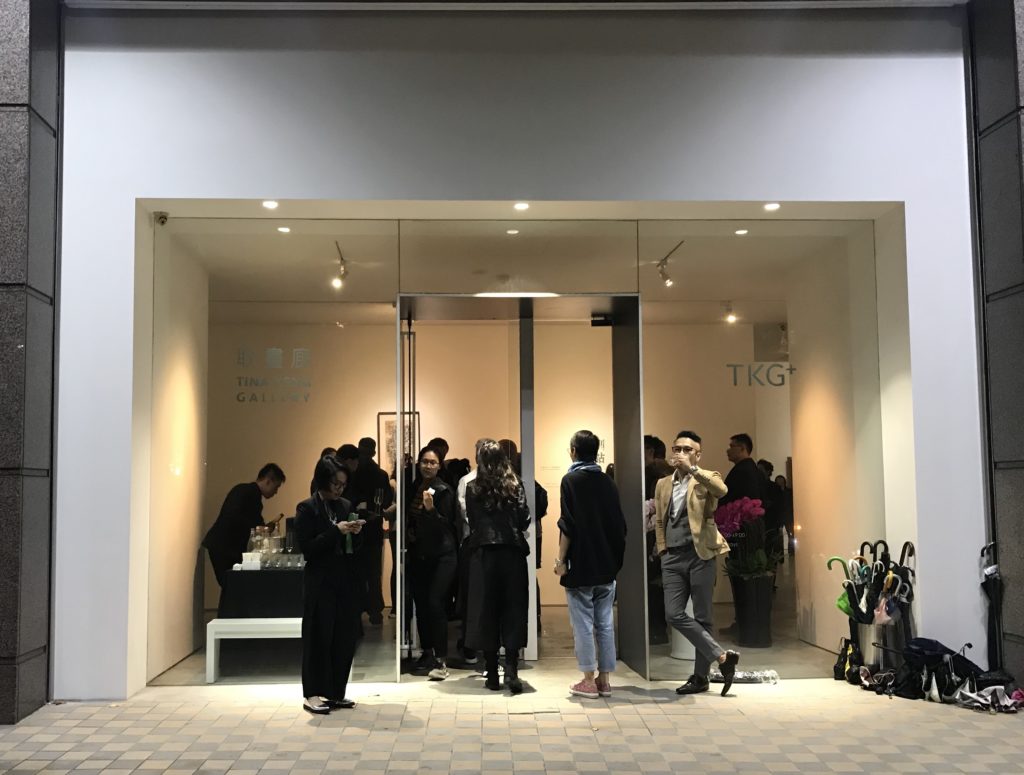
Guests at TKG+’s opening during the fair. Photo by Andrew Goldstein.
Exhibiting at Taipei Dangdai, TKG+ was in good company, surrounded by galleries hailing from Jakarta (ROH Projects), the Philippines (Silverlens), and Singapore (Yavuz). One exhibitor from Tokyo, Gallery Side 2, had a charming booth of delicate, emotive animal paintings by Yuko Murata in the under-$8,000 section. “For us, being in Japan, we feel very enclosed, so this is great exposer,” said the gallery’s Kaori Nagashima. “There’s Kusama and Murakami and Nara, but besides that no one knows any Japanese artists, I think.”
Several Asian galleries at the fair, trying to cover their bases on collectors’ appetites, brought a mix of international art. Taipei’s Nou Gallery, for example, offered a series of shang shui (“mountain-water”) landscapes by the 58-year-old Chinese artist Wang Tiande as well as a sculpture of a spiraling Gothic cathedral spire by the Dutch artist Wim Delvoye.
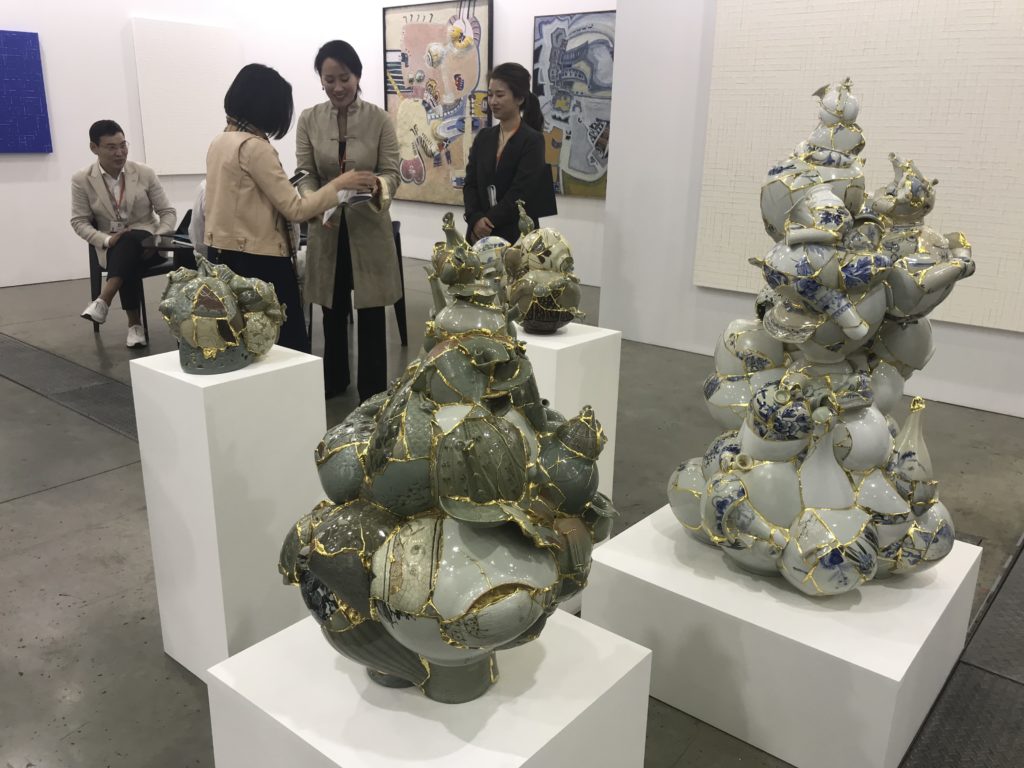
Sculptures by Yeesookyung at Gallery Hyundai’s booth. Photo by Andrew Goldstein.
“We want to introduce our Western artists to the Asian collectors,” said a dealer at Seoul’s Gallery Hyundai, which displayed reconstituted ceramic arrangements by Yeesookyung next to pieces by English artist Ryan Gander. “But we also want to make the Taiwanese collectors interested in the Korean artists—that hasn’t happened yet.”
The intermingling of art from both hemispheres gave Taipei Dangdai a dizzying vibrancy, seeming to broaden the opportunities for discovery beyond mere aesthetic appreciation to something closer to cultural understanding. David Tung, the former deputy director of Shanghai’s Yuz Museum who now oversees Lisson Gallery’s operations in China, viewed this melding as a critical step for both sides.
“If Chinese museums never collect Western artists, then China’s art will never be truly international,” he said. “The question is, when does that model reverse? When does someone from Asia run a major Western art company? No one ever thought Satya Nadella would run Microsoft.”
Beyond the Fair
By the end of the week, the consensus was that Taipei Dangdai had a solid start, with a level of quality that was respectful of the local audience and respectable enough sales to encourage dealers to invest in a second appearance.
Renfrew—who could be seen sprinting around his debut edition, smartphone in hand—has big plans for the fair, including growing its Asian roster and making more use of the exhibition hall. “My dream is to have really ambitious works hanging from the ceiling in coming years,” he said.
Members of the Taiwanese art scene are also excited about the possibilities for Taipei Dangdai, but some believe the future of Taiwanese art lies beyond the traditional market-based model that the fair represents.
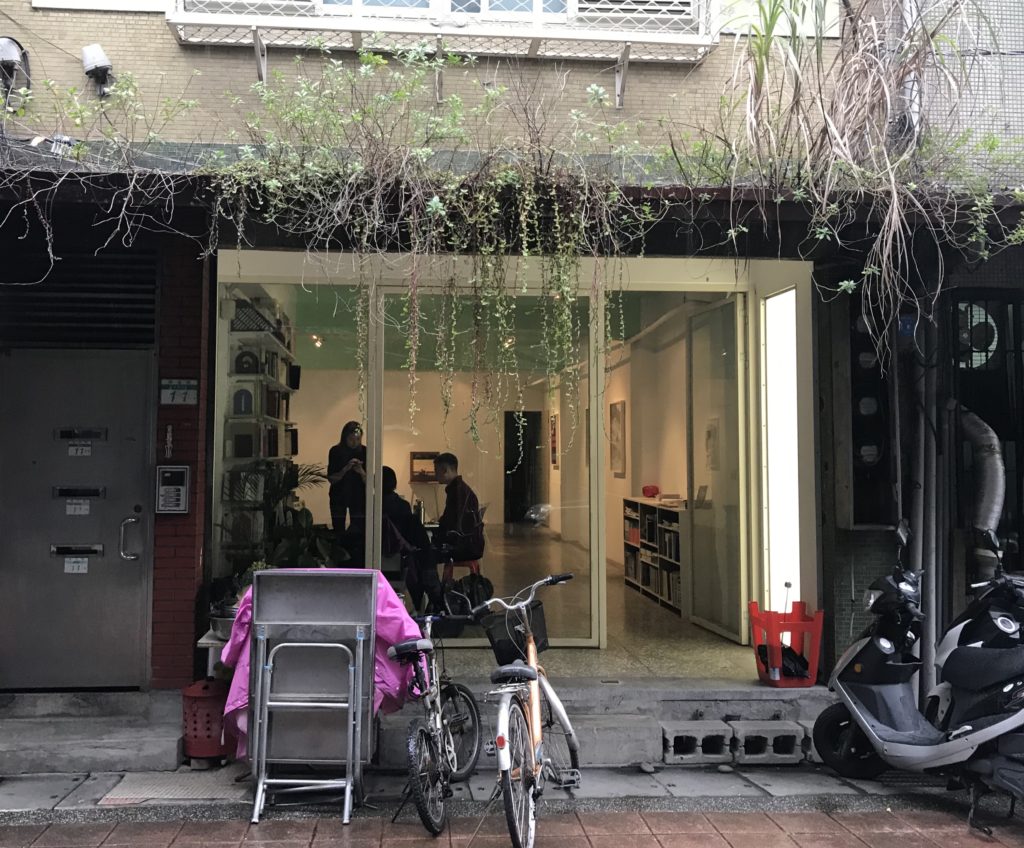
The Taipei Contemporary Art Center. Photo by Andrew Goldstein.
When asked about the key challenges for the country’s artists, Shih-yu Hsu, the director of the small but scrappy Taipei Contemporary Art Center, had a blunt answer: “China. Everyone wants to go for the Chinese artists. Taiwan is such a niche, because it’s not so driven by market forces. But that makes Taiwan’s art more interesting and more challenging than China.”
Because the Taiwanese government provides lavish cultural funding, the country’s artists tend to ignore market pressures and “do things that are more intangible,” she said. But this has also made their work less appealing to international collectors, who remain mostly committed to buying traditional painting and sculpture.
But will art always follow this path? A different trajectory is suggested by a visit to the Taiwan Contemporary Culture Lab (or C-LAB), a highly experimental exhibition space located on the seven-acre former ROC Air Force headquarters, incongruously located in Taipei’s center.
A recent tour of the rambling site by Wu Dar-Kuen, head of C-LAB’s curatorial division, traversed from one crumbling building to another, each given over to a work of immersive new-media art. There was the environment of flashing words and colors on giant screens set to propulsive music by Seoul’s Young-Hae Chang Heavy Industries. And there was the mesmeric augmented-reality work by Taiwanese artist Chih-Chien Chen, set in the air force’s former high command suite, that materialized first a fleet of attack helicopters flying through the room, then a giant fighter jet that menacingly followed the viewer around, as piped-in fog filled the space.
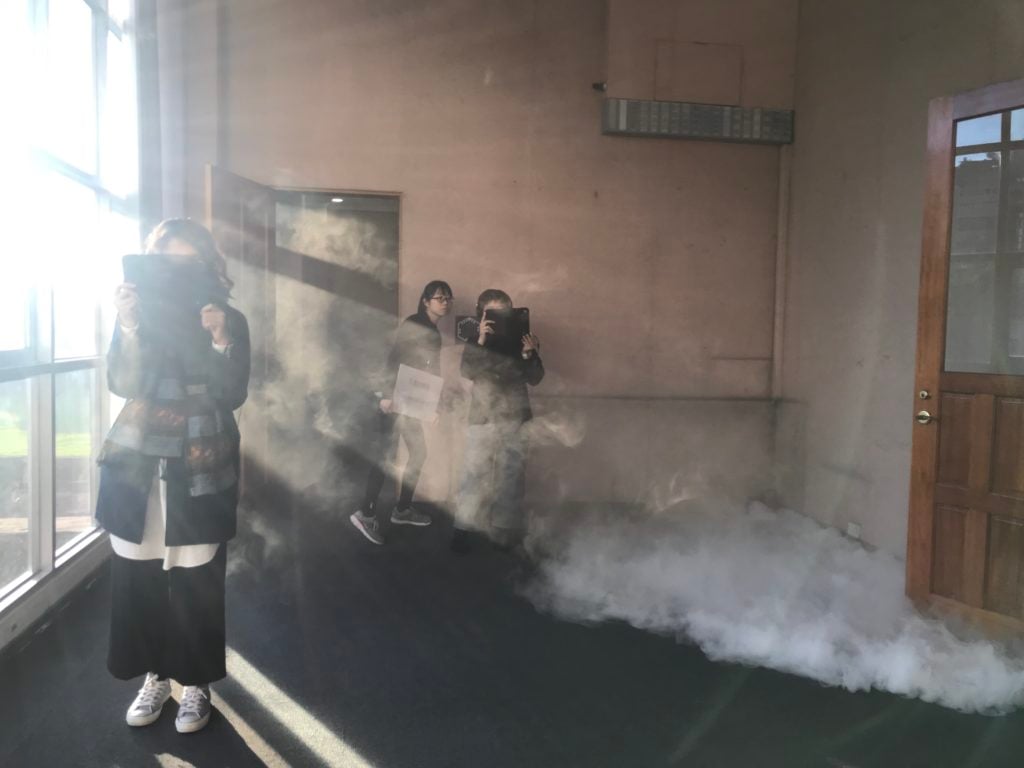
iPad-clutching visitors encountering Chih-Chien Chen’s augmented-reality installation at C-LAB. Photo by Andrew Goldstein.
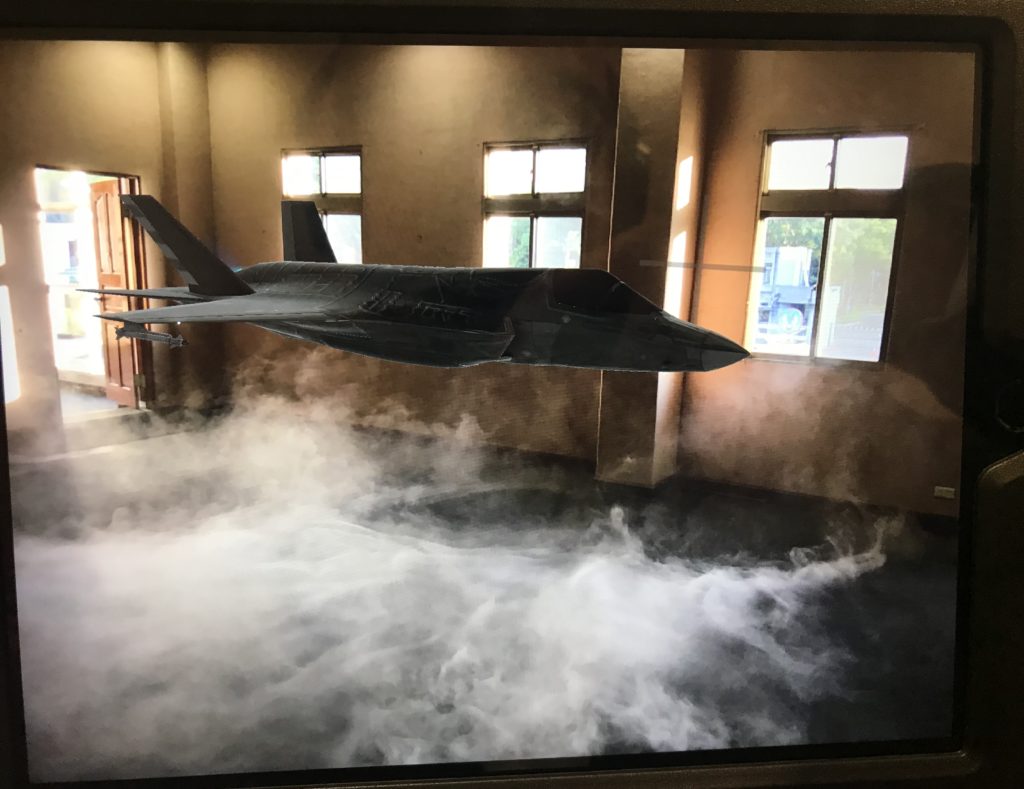
What the visitors saw. Photo by Andrew Goldstein.
Wu said that a master plan is being finalized with the culture ministry—whose newly re-elected minister, Cheng Li-chiun, is a staunch supporter of the project—to completely overhaul the campus, knocking down all but two buildings and rebuilding C-LAB as a next-generation art center with an audiovisual lab, a “social-innovation center,” and a contemporary art space designed for “the crossover of future art and performance art.” In other words, it will be purpose-built for art designed around experiences.
“We are trying to build a laboratory for full productions that bring together art, science, and society—the full ecosystem is very important,” Wu said. Asked what existing art site he saw as a model for this vision, he said documenta, the vast contemporary art exhibition that takes place every five years in Kassel, Germany.
Whether an art fair like Taipei Dangdai—and the market model it represents—can evolve to accommodate the art that a site like C-LAB produces remains a wide-open question.
